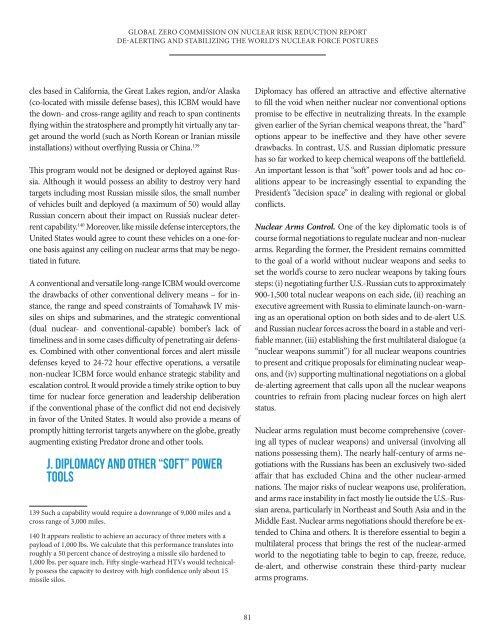global_zero_commission_on_nuclear_risk_reduction_report
global_zero_commission_on_nuclear_risk_reduction_report
global_zero_commission_on_nuclear_risk_reduction_report
Create successful ePaper yourself
Turn your PDF publications into a flip-book with our unique Google optimized e-Paper software.
GLOBAL ZERO COMMISSION ON NUCLEAR RISK REDUCTION REPORTDE-ALERTING AND STABILIZING THE WORLD’S NUCLEAR FORCE POSTUREScles based in California, the Great Lakes regi<strong>on</strong>, and/or Alaska(co-located with missile defense bases), this ICBM would havethe down- and cross-range agility and reach to span c<strong>on</strong>tinentsflying within the stratosphere and promptly hit virtually any targetaround the world (such as North Korean or Iranian missileinstallati<strong>on</strong>s) without overflying Russia or China. 139This program would not be designed or deployed against Russia.Although it would possess an ability to destroy very hardtargets including most Russian missile silos, the small numberof vehicles built and deployed (a maximum of 50) would allayRussian c<strong>on</strong>cern about their impact <strong>on</strong> Russia’s <strong>nuclear</strong> deterrentcapability. 140 Moreover, like missile defense interceptors, theUnited States would agree to count these vehicles <strong>on</strong> a <strong>on</strong>e-for<strong>on</strong>ebasis against any ceiling <strong>on</strong> <strong>nuclear</strong> arms that may be negotiatedin future.A c<strong>on</strong>venti<strong>on</strong>al and versatile l<strong>on</strong>g-range ICBM would overcomethe drawbacks of other c<strong>on</strong>venti<strong>on</strong>al delivery means – for instance,the range and speed c<strong>on</strong>straints of Tomahawk IV missiles<strong>on</strong> ships and submarines, and the strategic c<strong>on</strong>venti<strong>on</strong>al(dual <strong>nuclear</strong>- and c<strong>on</strong>venti<strong>on</strong>al-capable) bomber’s lack oftimeliness and in some cases difficulty of penetrating air defenses.Combined with other c<strong>on</strong>venti<strong>on</strong>al forces and alert missiledefenses keyed to 24-72 hour effective operati<strong>on</strong>s, a versatilen<strong>on</strong>-<strong>nuclear</strong> ICBM force would enhance strategic stability andescalati<strong>on</strong> c<strong>on</strong>trol. It would provide a timely strike opti<strong>on</strong> to buytime for <strong>nuclear</strong> force generati<strong>on</strong> and leadership deliberati<strong>on</strong>if the c<strong>on</strong>venti<strong>on</strong>al phase of the c<strong>on</strong>flict did not end decisivelyin favor of the United States. It would also provide a means ofpromptly hitting terrorist targets anywhere <strong>on</strong> the globe, greatlyaugmenting existing Predator dr<strong>on</strong>e and other tools.J. DIPLOMACY AND OTHER “SOFT” POWERTOOLS139 Such a capability would require a downrange of 9,000 miles and across range of 3,000 miles.140 It appears realistic to achieve an accuracy of three meters with apayload of 1,000 lbs. We calculate that this performance translates intoroughly a 50 percent chance of destroying a missile silo hardened to1,000 lbs. per square inch. Fifty single-warhead HTVs would technicallypossess the capacity to destroy with high c<strong>on</strong>fidence <strong>on</strong>ly about 15missile silos.Diplomacy has offered an attractive and effective alternativeto fill the void when neither <strong>nuclear</strong> nor c<strong>on</strong>venti<strong>on</strong>al opti<strong>on</strong>spromise to be effective in neutralizing threats. In the examplegiven earlier of the Syrian chemical weap<strong>on</strong>s threat, the “hard”opti<strong>on</strong>s appear to be ineffective and they have other severedrawbacks. In c<strong>on</strong>trast, U.S. and Russian diplomatic pressurehas so far worked to keep chemical weap<strong>on</strong>s off the battlefield.An important less<strong>on</strong> is that “soft” power tools and ad hoc coaliti<strong>on</strong>sappear to be increasingly essential to expanding thePresident’s “decisi<strong>on</strong> space” in dealing with regi<strong>on</strong>al or <str<strong>on</strong>g>global</str<strong>on</strong>g>c<strong>on</strong>flicts.Nuclear Arms C<strong>on</strong>trol. One of the key diplomatic tools is ofcourse formal negotiati<strong>on</strong>s to regulate <strong>nuclear</strong> and n<strong>on</strong>-<strong>nuclear</strong>arms. Regarding the former, the President remains committedto the goal of a world without <strong>nuclear</strong> weap<strong>on</strong>s and seeks toset the world’s course to <str<strong>on</strong>g>zero</str<strong>on</strong>g> <strong>nuclear</strong> weap<strong>on</strong>s by taking fourssteps: (i) negotiating further U.S.-Russian cuts to approximately900-1,500 total <strong>nuclear</strong> weap<strong>on</strong>s <strong>on</strong> each side, (ii) reaching anexecutive agreement with Russia to eliminate launch-<strong>on</strong>-warningas an operati<strong>on</strong>al opti<strong>on</strong> <strong>on</strong> both sides and to de-alert U.S.and Russian <strong>nuclear</strong> forces across the board in a stable and verifiablemanner, (iii) establishing the first multilateral dialogue (a“<strong>nuclear</strong> weap<strong>on</strong>s summit”) for all <strong>nuclear</strong> weap<strong>on</strong>s countriesto present and critique proposals for eliminating <strong>nuclear</strong> weap<strong>on</strong>s,and (iv) supporting multinati<strong>on</strong>al negotiati<strong>on</strong>s <strong>on</strong> a <str<strong>on</strong>g>global</str<strong>on</strong>g>de-alerting agreement that calls up<strong>on</strong> all the <strong>nuclear</strong> weap<strong>on</strong>scountries to refrain from placing <strong>nuclear</strong> forces <strong>on</strong> high alertstatus.Nuclear arms regulati<strong>on</strong> must become comprehensive (coveringall types of <strong>nuclear</strong> weap<strong>on</strong>s) and universal (involving allnati<strong>on</strong>s possessing them). The nearly half-century of arms negotiati<strong>on</strong>swith the Russians has been an exclusively two-sidedaffair that has excluded China and the other <strong>nuclear</strong>-armednati<strong>on</strong>s. The major <strong>risk</strong>s of <strong>nuclear</strong> weap<strong>on</strong>s use, proliferati<strong>on</strong>,and arms race instability in fact mostly lie outside the U.S.-Russianarena, particularly in Northeast and South Asia and in theMiddle East. Nuclear arms negotiati<strong>on</strong>s should therefore be extendedto China and others. It is therefore essential to begin amultilateral process that brings the rest of the <strong>nuclear</strong>-armedworld to the negotiating table to begin to cap, freeze, reduce,de-alert, and otherwise c<strong>on</strong>strain these third-party <strong>nuclear</strong>arms programs.81


